In this day in age, “Prepare for the worst, but hope for the best” is very good advice. Following those sage words, the Los Angeles County Health Department has taken preparedness to new heights to protect its citizens by purchasing two unique tractor-trailer combinations. Together, along with other emergency vehicles in their fleet, these two rigs make one high-tech mobile medical system. And although this system has never needed to be fully utilized, it is comforting to know that it is there, waiting and ready, if ever necessary.
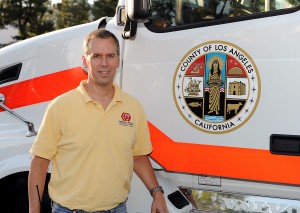 The Emergency Medical Services Agency (EMS) of L.A. County, a division of the Los Angeles County Health Department, oversees and coordinates all of the pre-hospital care in the county. Operating out of an indiscriminate non-marked warehouse in Los Angeles, the EMS crew, which is mostly made up of former nurses and emergency responders that are now licensed to drive big rigs, maintain these two trucks and several other vehicles, keep the medicines and supplies stocked, and continuously train and practice at setting up and using their equipment. They are always ready to “answer the call” and respond quickly and appropriately – especially since the 911 attacks in 2001.
The Emergency Medical Services Agency (EMS) of L.A. County, a division of the Los Angeles County Health Department, oversees and coordinates all of the pre-hospital care in the county. Operating out of an indiscriminate non-marked warehouse in Los Angeles, the EMS crew, which is mostly made up of former nurses and emergency responders that are now licensed to drive big rigs, maintain these two trucks and several other vehicles, keep the medicines and supplies stocked, and continuously train and practice at setting up and using their equipment. They are always ready to “answer the call” and respond quickly and appropriately – especially since the 911 attacks in 2001.
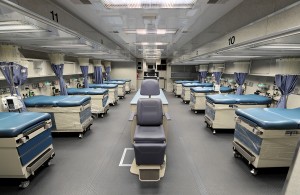 In the event of a major disaster or emergency, whether natural or otherwise, it is the EMS agency’s responsibility to coordinate various resources, keep communications efficient, bring necessary supplies and services where needed, and oversee all operations, in regards to emergency medical treatments. To help do this, the county purchased what they call MoMS (Mobile Medical System), which is a combination of a mobile emergency treatment center (the big rigs) and a portable field hospital. These systems, when combined, can create a state-of-the-art mobile medical facility for over 200+ people wherever necessary.
In the event of a major disaster or emergency, whether natural or otherwise, it is the EMS agency’s responsibility to coordinate various resources, keep communications efficient, bring necessary supplies and services where needed, and oversee all operations, in regards to emergency medical treatments. To help do this, the county purchased what they call MoMS (Mobile Medical System), which is a combination of a mobile emergency treatment center (the big rigs) and a portable field hospital. These systems, when combined, can create a state-of-the-art mobile medical facility for over 200+ people wherever necessary.
The big rigs are a pair of 2007 Volvo VN780 tractors pulling 53’ Featherlite trailers. Both of the tractors were built on a heavy duty chassis and feature Volvo D16 engines, 13-speed transmissions, and 100k watt generators. The main trailer features a 12-bed emergency exam and treatment center which, with its three large slideouts, allows for about 1,000 square feet of working space. Featherlite made the huge six-foot slideouts strong enough not to need additional supports on the outside of the unit. Inside this totally custom trailer, doctors can perform medical services like surgery, X-ray, lab work, ultrasounds and EKGs. There is also a 2-bed procedure area at the front of the trailer. An additional awning structure can be set up around the treatment trailer to expand patient capacity an additional 100 beds.
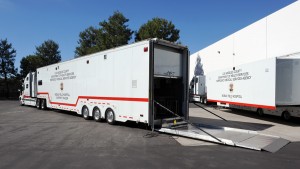 The second trailer, known as the support unit, is a fairly standard Featherlite race trailer, complete with two levels and a lounge in the front. This trailer holds all of the necessary equipment for the treatment trailer which includes the beds, chairs, machines, medical supplies, medicine, crash carts, IV pumps and poles, and everything else needed to operate the mobile exam and treatment (hospital) trailer. In transit, the hospital trailer is empty (everything is put into the support trailer), so once on-scene, all of the equipment and supplies need to be moved into place. With four people working, it takes about two hours to set everything up. To set up the additional 100-bed awning structure around the treatment trailer, it takes about ten people eight hours to complete.
The second trailer, known as the support unit, is a fairly standard Featherlite race trailer, complete with two levels and a lounge in the front. This trailer holds all of the necessary equipment for the treatment trailer which includes the beds, chairs, machines, medical supplies, medicine, crash carts, IV pumps and poles, and everything else needed to operate the mobile exam and treatment (hospital) trailer. In transit, the hospital trailer is empty (everything is put into the support trailer), so once on-scene, all of the equipment and supplies need to be moved into place. With four people working, it takes about two hours to set everything up. To set up the additional 100-bed awning structure around the treatment trailer, it takes about ten people eight hours to complete.
In addition to the pair of mobile hospital rigs, the EMS “disaster warehouse” also has a mobile decontamination trailer, which can provide emergency showers for large amounts of people who have been exposed to hazardous chemicals, and a mobile communications trailer, to keep emergency responders connected in the event of a system failure. Both of these trailers are pulled with Ford F650 Super Duty trucks. There is also about 50 mobile generators, several mobile oxygen concentrators (they turn regular air into purified medical oxygen), and a small fleet of extra-large ambulances in the warehouse. They also have four complete climately-controlled 25-bed “tent” setups that can connect together, via tunnels, to create a portable 100-bed field hospital. Each of these four setups is transported in 30-foot trailers pulled by four nicely-equipped Ford F350 pickups. All of the vehicles are painted white with a reflective red stripe, just like the pair of tractor-trailer combinations.
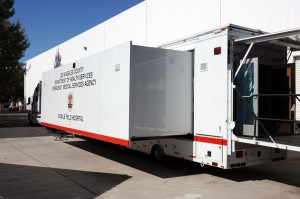 As you can see, there are several vehicles to maintain, which keeps the fleet manager, Dave Lee, very busy. Dave is the only guy in the warehouse with a trucking background, and because of this, he has taught several of the EMS staff how to drive a truck (many of them now have their CDL). Jerry Crow (seen in photo) has been with the Health Department for 12 years and a Registered Nurse (RN) for 29 years. Jerry, who earned his CDL a year ago, is the Mobile Hospital Program Manager, and John Ospital, also an RN, is the Team Deputy Commander (he is currently studying to get his CDL). Robert Smock is the guy that keeps the warehouse clean, fully-stocked and organized. Jim Eads, Chief of the Disaster Response Section, stressed that this operation is a true team effort saying, “If it weren’t for the dedication of this group of folks the MoMS would never get out the door.”
As you can see, there are several vehicles to maintain, which keeps the fleet manager, Dave Lee, very busy. Dave is the only guy in the warehouse with a trucking background, and because of this, he has taught several of the EMS staff how to drive a truck (many of them now have their CDL). Jerry Crow (seen in photo) has been with the Health Department for 12 years and a Registered Nurse (RN) for 29 years. Jerry, who earned his CDL a year ago, is the Mobile Hospital Program Manager, and John Ospital, also an RN, is the Team Deputy Commander (he is currently studying to get his CDL). Robert Smock is the guy that keeps the warehouse clean, fully-stocked and organized. Jim Eads, Chief of the Disaster Response Section, stressed that this operation is a true team effort saying, “If it weren’t for the dedication of this group of folks the MoMS would never get out the door.”
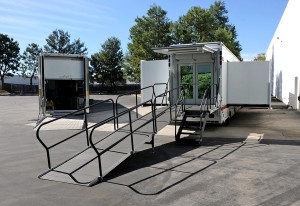 L.A. County has the largest EMS system in the country, and there is only one other agency in the United States (in North Carolina) that has a mobile hospital similar to this one. And at a cost of about $3.5 million just for the pair of big rigs, it is no wonder. The trucks are three years old now, and still only have about 6,000 miles on them. They may just sit and wait, but if and when they are ever needed, they will be ready to go at a moments notice. Although the MoMS is a Los Angeles County asset, the county does have agreements with other local counties, as well as other states, for mutual aid. The MoMS units can travel outside L.A. County to other areas to help, if ever needed.
L.A. County has the largest EMS system in the country, and there is only one other agency in the United States (in North Carolina) that has a mobile hospital similar to this one. And at a cost of about $3.5 million just for the pair of big rigs, it is no wonder. The trucks are three years old now, and still only have about 6,000 miles on them. They may just sit and wait, but if and when they are ever needed, they will be ready to go at a moments notice. Although the MoMS is a Los Angeles County asset, the county does have agreements with other local counties, as well as other states, for mutual aid. The MoMS units can travel outside L.A. County to other areas to help, if ever needed.
Jim Eads said it best when he stated, “This is a resource we hope we never have to use for its intended purpose, because if we do, a whole bunch of people are having a real bad day. We plan, train and exercise the MoMS so that if we are called we can be as efficient as possible in its deployment and operation.” So if you ever see these “Code 3” rigs out on the road with their lights flashing and sirens blaring, we suggest that you get out of the way and let this elite group of truck drivin’ nurses get to where they need to go – stat!

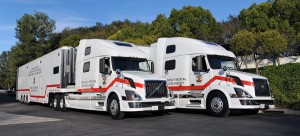
1 Comment
WOW- is this ever the greatest idea! I say we get these rigs rolling! Thank you!